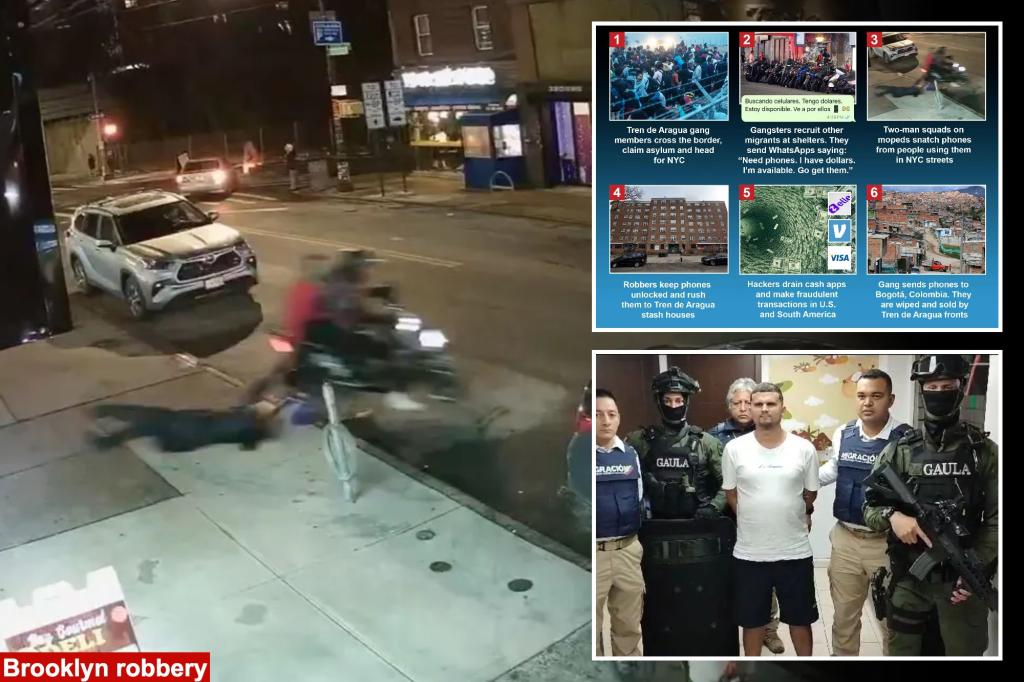Table of Contents
It’s a crime wave that has raised fears across the city: robbers on mopeds snatching people’s phones from their hands and speeding off.
In one especially brazen attack, the moped-riding bandits dragged a 62-year-old woman down a Brooklyn street in December.
After the phones are stolen, the victims’ bank and cash accounts are drained of cash, with fraudulent transactions in both the US and South America, and the phones themselves sent to Colombia to be wiped, reprogrammed and sold.
Now The Post can disclose that the pattern of robberies is being linked by law enforcement to a brutal Venezuelan gang which is sending its members to New York as part of the migrant wave — and using its sprawling criminal empire to launder the proceeds of the crimes.
Until recent weeks police had been concerned about rises in thefts and robberies in the city — such as a spate of pickpocketing on the subway system and around the Rockefeller Center Christmas tree — being linked to low-level, unorganized criminals who were among the estimated 170,000 migrants who have arrived in the city since the start of 2023.
But sources tell The Post that the brutal Venezuelan “Tren de Aragua” gang has moved into New York by having its members cross the southern border and claim asylum, and is likely behind many of the moped robberies.
It is the only new gang so far being tracked among the new migrant arrivals in the city, sources say.
The NYPD has not so far discussed the gang publicly — but at a briefing last week, senior officers described a pattern of moped robberies which The Post is told have the hallmarks of Tren de Aragua.
Separately, sources told The Post last Saturday that there were concerns a gang which assaulted a police officer in Times Square could be linked to Tren de Aragua. It was unclear if the 15-year-old Venezuelan arrested Friday over the Times Square shooting of a tourist has ties to the gang.
Last month, a suspect believed to be connected to Tren de Aragua was arrested after the brutal murder of a retired Venezuelan police officer who was lured to his death in Miami by a group of prostitutes.
And in Chicago, Cook County Sheriff Department’s intelligence division has been revealed by NBC5 Chicago to be tracking its presence in the city.
South American crime lords
Tren de Aragua, meaning Aragua Train, started in 2012 among trade union members in the Aragua province of Venezuela who turned a planned railroad into an opportunity for grift, and has exploded since then into a violent gang involved in robberies, drug-dealing and human trafficking across South America.
The Venezuelan government officially sees it as a criminal enterprise and sent in 11,000 soldiers on September 23 last year to take back a prison under the gang’s control in Tocorón, in the country’s interior.
But, The Post is told, its members have also been used as enforcers for the Cartel of the Suns drug trafficking network which the US Department of Justice alleges is run by Venezuelan strongman Nicolas Maduro from his presidential palace in Caracas.
They have now established presences in Columbia, Peru, Brazil and Chile under leader Niño Guerrero (“Warrior Kid”) whose real name is Héctor Rustherford Guerrero Flores and who escaped the prison raid safely along with around 80 other senior leaders.
Their violent practices have shocked even the most hardened in South America, particularly for their willingness to kill women.
Ammon Blair, a former Border Patrol agent and senior fellow at the Texas Public Policy Foundation, a conservative think tank, said: “They go into local economies where there are Venezuelans and take over the criminal underground using excessive force.
“They’ll start shooting prostitutes controlled by rival gangs and perform the executions live on social media in order to establish their presence.”
In Colombia in January, a series of brutal murders saw people lured to hotel rooms by Tren de Arauga members, tortured and killed, with their ordeals recorded for other gang members. One young man was tied hand and foot, strangled with a cable and beaten with a hammer before being shot.
The gang’s leader in Colombia, José Manuel Vera, calls himself “Satan,” and was arrested after trying to extort businesses in a series of towns, with bloodthirsty demands sent in WhatsApp voice notes.
When the owners did not pay up, their employees were kidnapped tortured and dismembered, their body parts bound in tarps and dumped outside the businesses.
In Lima, Peru, last February, a transgender prostitute was shot point blank 31 times and the murder put on social media — a warning that Tren de Aragua now ran city’s the sex trade. It was the start of a bloodbath: 24 Lima prostitutes were murdered in 2023, apparently by the gang.
In Chile, dismembered victims’ bones have been found in cement at building sites, and the country’s prosecutor held criss talks with his Columbian counterpart about the gang’s threat to law and order.
Exploiting the border
Gang members began making their way from Venezuela to the southern US border in 2017, Blair told The Post.
That year, there were nearly 2,800 “encounters” with Venezuelan migrants at the border, according to US Custom and Border Protection statistics.
But from October 2022 to September 2023, more than 334,000 Venezuelans crossed the border — second only to 735,000 Mexicans — with Tren de Aragua playing a key part in trafficking many from Venezuela.
“When they crossed the border into Colombia, they began to control everyone’s passage, charging fees to other Venezuelans to make the crossing,” said Robert Almonte, a security consultant and former El Paso US Marshal.
Border Patrol agents apprehended 41 Tren de Aragua members crossing the border between October 2022 and September 2023, according to US Customs and Border Protection.
The only signs that they belong to the ruthless group are tattoos featuring rifles and skulls, Almonte said — although they have started telling new members not to get tattoos to evade police.
They also favor tattoos of silhouetted basketball players and basketball jerseys emblazoned with Michael Jordan’s and LeBron James’ number, “23” — a reference to the date of the prison raid.
Alamonte said the group is so brazen that a Texas state anti-gang task force recently documented them charging fellow Venezuelans to use federal toilet facilities at the border.
Recruiting in NYC’s shelters
Tren de Aragua members are among the arrivals in New York, but also use the surge of new migrants at shelters in the city to recruit criminals.
The NYPD’s Chief of Detectives, Joseph Kenny, revealed last week how cops had busted one set of moped bandits — and although he did not say they were from Tren de Aragua, sources told The Post that the pattern is exactly how the Venezuelan gang has been operating in South America cities.
Kenny said last Monday that 62 robberies in the city since November 2023, 34 of them in Manhattan, had been linked to the single group of at least 14 people, who used two-man moped crews to snatch victim’s phones and, because the majority of victims were women, purses.
Most of the robbers were living in the migrant shelters, and had received orders via WhatsApp from a mastermind Chief Kenny named as Victor Parra, a 30-year-old Venezuelan migrant who arrived last year.
“Parra will send out specific orders for what type of phone he is looking for,” Chief Kenny said.
“Once the messages are received, the crime wave begins with the scooter operators making $100 a day and the actual phone snatcher making between $300 to $600 per phone that is stolen.”
Sources told The Post that the pattern matched how Tren de Aragua operates in South America, with gang members recruiting among the young men — in New York’s case, in migrant shelters — and using stolen scooters to move around the city.
Because Tren de Aragua is involved in human trafficking, gang recruiters may also have phone numbers for many of the migrants who come to New York, allowing them to blast mass WhatsApp messages to scores or hundreds of people at a time.
Turning phones into ‘gold’
Kenny said that the stolen phones had been taken to alleged mastermind Parra’s home — a NYCHA apartment in the Parkside Houses in the Bronx — where a “hacker” drained them of cash. A raid early last Monday uncovered 22 stolen phones and victims’ IDs.
But the actual robbers play a crucial part. The driver maneuvers the moped and the grabber latches onto a phone, wrenching it from the victim — who crucially, was using it.
Phone in hand, the grabber, riding on the back of the bike, then stops the phone from locking.
“He may keep tapping it,” Jonathan S. Weissman, cybersecurity professor at Rochester Institute of Technology, told The Post. “Or else he can set the phone to ‘never’ on auto-lock. That way, the thieves keep it alive without needing to tap the screen.”
Once delivered to the safe house the hackers get to work, hunting for bank accounts, payment apps and credit cards.
According to experts, they can change codes, making it difficult for victims to stop the speedy ransacking of their accounts. Having stolen IDs from purses also helps them hack.
“Most of the security codes can be reset via SMS,” Jayson E. Street, chief adversarial officer for Secure Yetti, told The Post. “You communicate to the apps that you forgot your passcodes. They can then be reset by putting in the that verification codes that are sent to the phone.”
The hacked phones can be exceptionally valuable. “The apps are used to make illegal transactions and fraudulent purchases in the United States and South America,” the NYPD’s Kenny.
With money drained or the accounts frozen by the victim, the phone is still valuable: it is shipped to Colombia, Chief Kenny said.
Sources told The Post that Tren de Aragua has a network carrying out the work, with phones wiped by its operatives in Bogotá then sold across South America.
Said Weissman, “It’s the equivalent of melting down stolen gold.”
‘Ghost’ criminals
At the NYPD’s press conference, Chief Kenny warned the robbery gangs were “ghosts”. “No criminal history, no photos, no cell phone, no social media. Sometimes we’re even unclear on a name or a date of birth.”
Of the 14 identified as being in the robbery gang, cops have so far arrested seven and Varra remains on the run.
NYPD sources said migrants have exploited the ID NYC scheme by getting different IDs at the Roosevelt and Floyd Bennett Field shelters.
Statistics show robberies up 9% citywide in 2024, from 1,164 to 1,278, compared to the same period in 2023, and up 14% on the same period in 2022.
Grand larcenies — theft of more than $1,000, which would include mobile phones which were drained of cash — were also up 1.6%, to 3,726, for the four weeks ending February 4, compared to 3,666 for the same four weeks in 2023.
But Tren de Aragua’s biggest ghost is its leader, Niño Guerrero. An Interpol “red” notice, requesting his arrest, warns that the mastermind’s whereabouts is unknown.
Among the countries he could be in: The United States.


